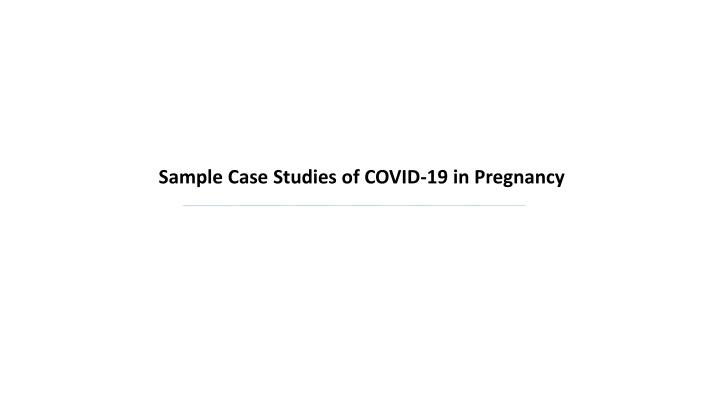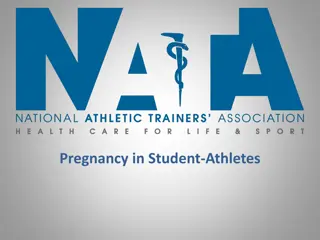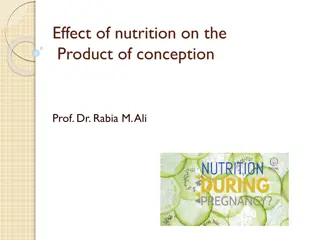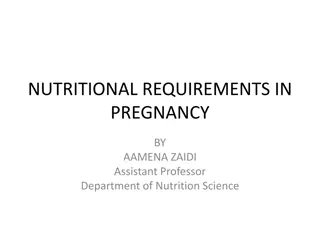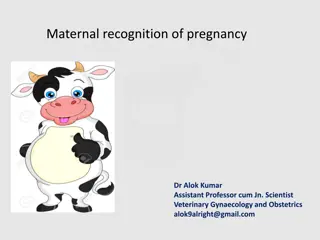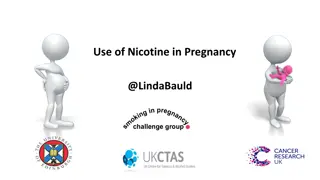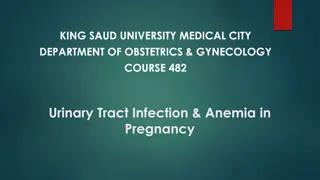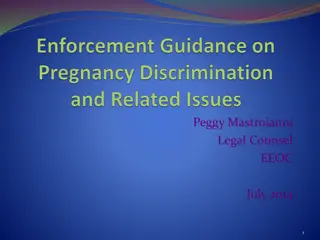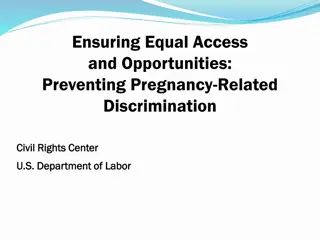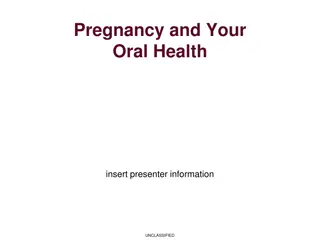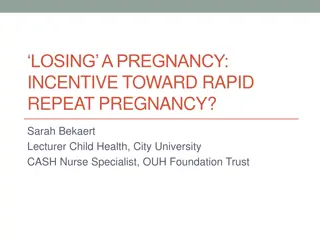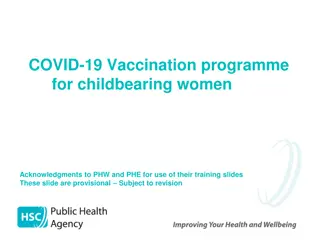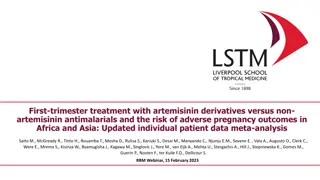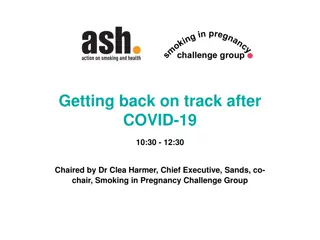Insights into COVID-19 Management in Pregnancy
This content presents a detailed case study of a 33-year-old pregnant woman with suspected COVID-19, covering her symptoms, diagnostic tests, admission criteria, treatment considerations, and post-recovery follow-up. It also discusses triage assessment, investigations, and admission protocols for pregnant individuals with COVID-19. Additionally, it outlines surveillance and warning signs for monitoring COVID-19 patients in pregnancy, providing valuable insights for healthcare professionals.
Download Presentation

Please find below an Image/Link to download the presentation.
The content on the website is provided AS IS for your information and personal use only. It may not be sold, licensed, or shared on other websites without obtaining consent from the author.If you encounter any issues during the download, it is possible that the publisher has removed the file from their server.
You are allowed to download the files provided on this website for personal or commercial use, subject to the condition that they are used lawfully. All files are the property of their respective owners.
The content on the website is provided AS IS for your information and personal use only. It may not be sold, licensed, or shared on other websites without obtaining consent from the author.
E N D
Presentation Transcript
Case #1 33 yo G2P1 at 29w GA Presents with temp of 38oC, dry cough, shivering, general unwell for 9 days NP swab for COVID-19 was taken CXR: Left low lobe opacity 1. Should this patient be admitted? Based on what illness criteria? 2. What bloodwork should be ordered? 3. Where should she be admitted? 4. Is there a role for enoxaparin? 5. Is there a role for celestone? 6. If she is COVID +, when will she be recovered .will she need any post recovery swab? 7. Will she need any post recovery fetal follow up?
COVID-19 & Triage Assessment: Patient presents to triage with COVID symptoms AND/OR an OBS concern: Criteria for discharge home from triage: 1. Stable vital signs (HR < 100, RR 15-20, temp < 38oC, O2 sat > 94% on RA) 2. No oxygen requirement 3. No shortness of breath or work of breathing 4. Suitable for phone call follow up (through Public Health) 5. No acute obstetrical concerns 6. No other concerning co-morbidities COVID Indications for admission: (based on illness assessment +/- co-morbidity) o Shortness of breath (unable to walk across room, speak full sentence) o Cough with blood o Chest pain o S/S dehydration o Decreased level of consciousness o Oxygen saturation < 94% o CXR consistent with pneumonia (ground glass opacities)
COVID-19 & Investigations: Admission Investigations: Baseline at admission, repeat as indicated o COVID NP swab o Routine bloodwork: lytes, creatinine, lactate o Prognostic bloodwork: CBC, PT, PTT, CRP, LDH, ferritin, fibrinogen, d-dimer (not to be used to detect risk of VTE as in non-pregnant population) o Lactate, Venous blood gas (if abnormal proceed to arterial blood gas) o BNP, troponin if any concern for cardiac involvement o Urine PCR , uric acid +/- PLGF if any concern for PET o Cultures: any concern for co-infections o ECG o CXR o 2D ECHO (maternal) if severe illness/ICU admission/underlying cardiac condition ** if known cardiac disease consult with Cardiology to determine if should get an ECHO o CT scan only if clinically indicated (rule out pulmonary embolism) * Consultation with ID , OB Medicine and ACCESS (ICU)
COVID-19 Admission and Surveillance: Location depends on the local facility: Antenatal ward in level III centre Medicine ward in community setting Surveillance & Warning signs - Vitals with O2 saturation q4h- if requiring oxygen support increase vitals to q hourly with 1:1 RN care - If requires: New use of oxygen support RR increases despite normal O2 saturation Increasing amount of oxygen to maintain saturation >94% ** WARNING SIGN OF RESPIRATORY DETERIORATION: COVID SPECIFIC - Warning signs of maternal deterioration Increased O2 demands by 50% over 1-2h O2 sat < 94% despite O2 support >4.0L O2 by facemask Valid & Accurate & Applicable For Maternal Illness Assessment - High rate of detection (sensitive; true positive) - High negative predictive rate (specific; true negative) - Low rate of false positive (alert fatigue) - Tailored to the clinic setting, patient population MEOWS: Maternal Early Obstetrical Warning Score 2 yellow or 1 red alert triggers MD evaluation
COVID-19 & Antenatal Management: Role for thromboprophylaxis: - - - Any pregnant patient admitted to hospital for any indication is at risk for VTE In COVID- hypercoagulable state In GIM population, use of enoxaparin decreased mortality in patients with COVID severe illness Recommend: VTE prophylaxis for pregnant patients admitted with moderate to severe disease COVID - duration depends on clinical scenario ie: moderate disease & delivered by C/S in patient with elevated BMI: duration based on OB recommendations moderate disease admitted for COVID care & no other co-morbidities: duration of admission Role for Celestone: Corticosteroid Guidance for Pregnancy during COVID-19 Pandemic Jennifer Jury McIntosh, DO, MD DOI https://doi.org/ 10.1055/s-0040-1709684. - - lowest quality of evidence... authors opinion... leap from high dose/duration in ICU patient SUPPORT THE USE OF CELESTONE IF AN IDENTIFIED RISK FOR PRETERM BIRTH
COVID-19 Recovery Algorithm 1. COVID diagnosis confirmed. Stays as an outpatient. Performs 14d self-isolation. Now has no symptoms consider COVID recovered. Does not need a swab for "test of cure". Can come back into medical system as COVID recovered/not infectious/negative. 2. COVID diagnosis confirmed, admitted for COVID support but then discharged before the 14d completed. Complete 14d self-isolation. Now has no symptoms, consider COVID recovered. Does not need a swab for "test of cure". Can come back into medical system as COVID recovered/not infectious/negative. 3. COVID diagnosis confirmed, admitted for COVID support and/or OB indication and is NOT discharged. At day 14 and with no symptoms we should perform 2 sets of NP swabs separated by 24h- both need to be negative and then she will be clear and released from droplet precaution (as per IPAC at MSH) Then she will be treated by us as COVID recovered/not infectious/negative. *** If still antepartum: Ongoing fetal surveillance within 14d of discharge: BPP with Doppler and EFW
Case #2 40 yo G2P1 at 27w GA Works in seniors home Presents with 4d Hx of cough, malaise, fever PMHx: Sickle cell disease (Rx with exchange transfusion; no VOC in pregnancy) ? Does she have COVID ? How do you make the diagnosis ? Should she be admitted ? Should she have antibiotics ? What are the maternal warning signs of deterioration ? What are the indications for ICU admission ? Should she be delivered
Inpatient care algorithm Key Points: 1. Dx made by NP swab 2. CXR and bloodwork defines Dx severity 3. Additional tests based on co-morbidity 4. Treatment is supportive * no ABX unless superimposed infection 5. Warning signs as per any @risk OB patient * COVID specific respiratory signs
Delivery Considerations with COVID-19 1. COVID-19 infection is NOT a direct indication for delivery 2. Decision to deliver is individualized based on maternal & fetal status, GA Principles: a. If < 28w GA & can maintain mechanical ventilation: Ext Mx .. risk of prematurity > risk of IUFD b. If <28w GA & can NOT maintain mechanical ventilation . ? Would delivery improve ventilation status c. If > 28w GA & can maintain mechanical ventilation . Consider delivery if signs of non-reassuring fetal status* d. If >28 w GA & CAN NOT maintain mechanical ventilation: . Consider delivery to manage ventilation ** * Fetal monitoring will be abnormal: tachycardia, minimal variability decide frequency & what criteria to act upon ** NOT to improve maternal disease process, not to alter fetal/neonatal outcome, but to facilitate the ventilation *** if delivering < 34w GA, give MgSO4 4g bolus before delivery- over 1 hour to limit maternal respiratory depression
Case #3 38yo 38wGA Admitted for IOL: DM type II (poor control HbA1c 11%); Intrahepatic cholestasis of pregnancy, BMI 48 In labor, develops fever 38.8oC . 1. Is this patient a PUI? 2. What steps should be taken? 3. Difficult to pick up FHR ? can FSE be applied 4. FHR is abnormal at 9cm . ? can a scalp lactate be taken to confirm fetal well-being 5. Decision to proceed to C/S: ? what should the team DON ? where will the team DOFF 6. Newborn management ? Should we do delayed cord clamping ? Should she breastfeed 7. Does she need ppVTE prophylaxis
Key Points for Fever in Labor - - - - Temperature >37.8oC Give 500 cc fluid bolus (takes 30 min). DO NOT GIVE TYELENOL DURING THIS TIME Repeat temperature 30 min after bolus completed If still >37.8 (or any other symptoms) . - - - Patient is now a PUI NP swab for COVID Initiate Droplet /Contact Precautions IF > 38oC initiate chorioamnionitis workup and treatment Blood cultures, Tyelenol, Broad spectrum ABX - - After birth- Neonate also a PUI: perform NP swab ** Note: if using Misoprostil use for term IOL: - 25-50 g dose for IOL will not give maternal temperature
COVID-19 and Intrapartum Management: Key Points - Regardless of GA and disease severity: recommend hospital birth - Regardless of GA: CEFM based on case reports of fetal compromise in women with COVID-19 diagnosis (8/18 44% incidence) - If mild symptoms: Maternal vital signs (HR, BP, RR, O2 sat) q 2h. - If moderate symptoms: Maternal vital signs (HR, BP, RR, O2 sat) q 1h. Oxygen to keep O2 sat >94% - Hourly fluid status to avoid fluid overload (affects ventilation, work of breathing) - No hydrotherapy in labor/birth (risk of virus in feces? Infectious) - Encourage epidural anesthesia: minimize risk for GA - No evidence of virus in vaginal secretions/amniotic fluid: use Fetal Scalp Electrode and Scalp lactate sampling as per OB indications - No use of nitrous oxide for pain management (potential aersolization) - No indication for C/S unless to improve maternal resuscitation efforts - Emergent C/S for OB indications not because of COVID diagnosis - Elective C/S should not be delayed based on COVID diagnosis unless need for maternal stabilization. - COVID diagnosis is not an indication for IOL; diagnosis of COVID is not a reason to delay an indication/urgent IOL unless need for maternal stabilization. - Consideration: If SOB, maternal exhaustion or increasing hypoxia: may use assisted vaginal birth to shorten the second stage
COVID: Donning and Doffing PPE: DONNING PROCESS This order suggested by Public Health does not account for the need for the surgical scrub for a C/S This is a series of videos to guide OBs for DON and DOFF based on our unique patient interactions. This videos are based at Sinai Health System but do provide guidance for principles Remember to DON outside the patient room/OR: in a clean space If have a negative pressure room: the anteroom considered contaminated Don outside the room/OR
COVID: Donning and Doffing PPE: DOFFING PROCESS This order suggested by Public Health does not account for the need for the extra protective gear an OB would wear at a delivery Principle of Doffing: dirtiest to cleanest After a delivery: 1. Removes shoe covers 2. May consider to untie dirty gown with gloves on and then remove gown gloves often pull off with the gown Remember to DOFF inside the patient room/OR: EXCEPT MASK DOFF Mask outside the patient room/OR * If have negative pressure room DOFF all PPE in the anteroom
Key Points for Newborn to COVID +/PUI mom: 1. Based on: No evidence of virus in cord blood SUPPPORT DELAYED CORD CLAMPING Fetus was exposed to cord blood Limited evidence of vertical transmission 2. Support breastfeeding* Mother to wear mask 3. Support skin to skin 4. Any direct baby care * https://www.cps.ca/en/documents/position/breastfeeding-when-mothers-have-suspected-or-proven-covid-19
COVID-19 & Postpartum Thromboprophylaxis: Recommend: 1. OB indications for VTE prophylaxis 2. If no OB indications: a. mild COVID disease not required b. moderate & severe disease- recommend as shown to decreased mortality in GIM patients
Case #4 33 yo G1P0 at 39w5d Uncomplicated pregnancy followed by family practice Presents to hospital with decreased FM As part of OTAS assessment, triage RN places FHR monitor- FHR 70-80 BPM, confirmed against maternal HR 110 bpm . RN calls the OBSTERICAL EMERGENCY CODE 1. Is this patient a PUI? 2. Do we need to use PPE to assess the patient? 3. Once in OR, FHR still low .For stat C/S with plan for GA ? Does anyone require an N95 Mask
UNIVERSAL PRECAUTIONS FOR ANY NON-COVID BIRTH: This is the Universal standard of Personal Protection Equipment at ANY Birth: not COVID +/PUI !!! Goal is to protect against any pathogen contamination at a birth: SHOES COVERS WATER IMPERMEABLE GOWN HAT (MAY USE OWN FABRIC CAP) MASK EYE PROTECTION (MAY USE OWN GOGGLES) STERILE GLOVES In the OR at a C/S, the glove and gowns will be donned using sterile technique after the scrub NOTE:
PPE at an AGMP: Procedures for which an N95 Mask should be worn by the anesthesia team
Case #5 32yo G1P0 at 27w GA Presents to triage with meconium stained AFV after ? ROM, no contractions In triage: No FHR detected. Consult OB: confirm diagnosis of IUFD ? how should labor be induced ? in labor develops fever: is this patient now a PUI
Key Points for TOP: Antenatal Unit or L&D Patient is screened at hospital entry & on admission to unit (with maternal temp check) Screen negative (asymptomatic) Screen positive (symptomatic).. Patient is a PUI Proceed to IOL NP Swab and Droplet/ Contact Precaution 1st dose of misoprostil with Tyelenol (1g) po 1st dose of misoprostil + Tyelenol (1g) po Dose misoprostil q 4h Dose Tyelenol q6h (standing, regardless of maternal temp) Dose misoprostil q 4h Dose Tyelenol q6h (standing, regardless of maternal temp) If temp > 37.8oC: bolus 500cc over 30 min Recheck temp 30 min after bolus complete If remains >37.8oC patient is now a PUI * Can substitute ASA (325mg) if allergy NP swab and Droplet/Contact Precautions
Case #6 32 yo G2P1 at 33w GA - GDM insulin; no BPP yet in pregnancy - Telephone pre-screen before booked OB visit: runny nose ? What should you do ? NP swab positive for COVID ? You call her for virtual OB visit and to discuss COVID diagnosis in pregnancy a. does she need to be admitted b. when will she be COVID recovered c. what is the impact on her baby
Outpatient screening algorithm Key Points: 1. Screen positive patient needs an NP swab 2. To guide admission use: illness criteria co-morbidities physical exam investigations 3. Ensure patient is reliable /safe for telephone F/U 4. Review warning signs with patient
COVID-19 and Pregnancy Key Points for Patients: - Pregnant patients affected by COVID-19 make full recovery - 15-20% develop a moderate to severe illness (2 case reports of maternal death; social media reports ) - No data to suggest increased risk of T1/T2 SA or teratogenicity - Limited evidence suggest vertical transmission is possible: to date babies born to COVID + moms have been well - Limited evidence suggests no increased risk of spontaneous preterm birth (labor) - Several cases of preterm birth: indicated for maternal health concerns OR fetal health concerns. - No data to suggest increased risk of IUFD - Based on data from SARS and MERS and other respiratory infection in pregnancy: - minimal effect on long-term fetal growth/wellbeing - suggest F/U OB scan once recovered
Case #7 32 yo G2P1 at 39w GA - Presents with UC q 3min, ROM for clear fluid, GBS negative - OBHx: diagnosed with COVID at 31w GA ? Any special precautions ? What will you wear at the delivery ? Are there any special tests ? Can she BF, skin to skin
Having a baby after COVID infection ! In the current state: 1. Screening at hospital entry 2. Screened with maternal temp in OB triage / labor 3. Treat as any screen negative patient 4. No special precautions for Labor & Delivery unless indicated by screening 5. Use universal precautions with the delivery: OB provider: surgical mask, hat, eye protection, gloves and gown, shoe covers Anesthesia: surgical mask, eye protection, gloves, gown and N95 mask if she requires intubation RN: surgical mask, hat, eye protection, gloves and gown, shoe covers 6. Baby will NOT have an NP swab. 7. Mother & partner will NOT mask when having contact with baby (Skin to skin, BF...).
